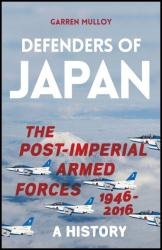 Название: Defenders of Japan: The Post-Imperial Armed Forces 1946-2016, A History
Название: Defenders of Japan: The Post-Imperial Armed Forces 1946-2016, A HistoryАвтор: Garren Mulloy
Издательство: Hurst & Company., Oxford University Press
Год: 2021
Страниц: 320
Язык: английский
Формат: epub
Размер: 10.1 MB
Japan's post-war armed forces are a paradox, both embarrassing remnants of the past and valuable repositories of experience.
This book charts the development of the Japan Self-Defense Forces (JSDF) from 1954 as both unorthodox military institutions and servants of a civil society that decries militarism. Investigating JSDF contributions to Japanese and global security, the evolution of such contributions during and after the Cold War, and their possible reconfiguration for Japan's security needs ahead, Garren Mulloy offers insight into the Forces' past, present and future. He explores the characteristics and contradictions of Japanese policy, including novel approaches in response to an increasingly assertive China, the latent threat of North Korea and contributory pressure from the US.
This work attempts to illuminate the arena of Japanese defence by focusing upon the actors, the defenders of Japan. While these are primarily the JSDF, the Forces are not the only parties engaged in defence activities. During the post-war occupation, United States armed forces constituted Japan’s primary security actors, and they continued this role during the Cold War as JSDF capabilities gradually developed. Coastguard forces also grew in importance, gaining prominence in disputes and conflicts with neighbouring states, and thus became the first Japanese armed forces, purely civilian, to engage in armed combat and inflict fatal casualties. Support for armed forces has come from civilian officials of agencies and ministries in technical, intelligence, and policy roles, who were engaged in an undeclared, ill-defined battle for control and influence over Japan’s defence with both those they support, the armed forces, and those they serve, the politicians.
Though the American alliance remains the core of Japanese security, new partnerships and international overtures will also shape the Forces' place in Prime Minister Abe's new vision of 'proactive contributions to peace'. Defenders of Japan deconstructs how the JSDF have adapted and will continue to adapt within domestic norms, caught between unresolved legacies of Japan's imperial past and a dynamically shifting balance of future global power.
The structure of this volume may seem rather unambitious. Themes such as militarism, civilian control, or International Relations (IR) theory in Japanese defence could occupy whole chapters, as could studies of each Force, each civilian actor, and obviously the constitution, but such an approach would involve a dislocation from chronology, confusing for many non-specialist readers, while also reducing the degree of integrated study of actors, events, and themes required to address the research puzzle. Therefore, the structure is based upon simple division into four periods, and, within each period, by subjects. The post-war and early Cold War period is covered in Chapter One, which examines Japan’s conflicted military legacy in the postimperial era. This includes Japan’s war-legacy personnel and conflicts, the development of para-military forces and first post-war casualties, an assessment of the impact these had upon society, politics, and the emerging Forces’ structures, tasks, culture, and capabilities. Chapter Two examines the unique foundations of the three Forces, how they developed during the Cold War, as institutions and within Cold War defence and security plans and strategy, and how effectively they conducted their core tasks and duties. Each Force is examined in turn, not only for defence capabilities, but also for social-cultural characteristics, with extensive cross-referencing and contextualisation, including how seriously security threats were assessed and measures taken to secure Japan in conjunction with US forces and Japanese civilian agencies. Chapter Three examines the post-Cold War period and the way Japan and the JSDF dealt with emerging security challenges, as well as domestic issues in a new era of uncertainty. The chapter concludes with JSDF efforts to meet extant and emergent East Asian threats and challenges, by examining the three main security challenges from the Cold War to the twenty-first century: Russia, China, and North Korea. Chapter Four examines the Forces as the primary defenders of Japan in the post-post-Cold War period of the new century, how they coordinate with civilian defence and security actors, as well as present and future concerns for Japanese security.
"A unique work. Mulloy does an excellent job of bringing together, in almost encyclopaedic detail, a range of Japanese and English sources. Combining this much information and analysis is extremely expert and quite an achievement. An important addition to works on the JSDF." -- Chris Hughes, Professor of International Politics and Japanese Studies, University of Warwick
Скачать Defenders of Japan: The Post-Imperial Armed Forces 1946-2016, A History